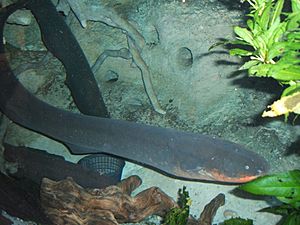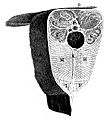Electric eel facts for kids
Quick facts for kids Electric eel |
|
|---|---|
 |
|
| Scientific classification | |
| Kingdom: | |
| Phylum: | |
| Class: | |
| Order: | |
| Family: |
Gymnotidae
|
| Genus: |
Electrophorus
|
| Binomial name | |
| Electrophorus electricus (Linnaeus, 1766)
|
|
The electric eel, known scientifically as Electrophorus electricus, is a special type of fish. It can grow quite large, sometimes weighing up to six pounds. This amazing animal can create powerful electric shocks, up to 650 watts! It uses these shocks to both catch its food and protect itself from danger.
Electric eels live in the slow-moving, muddy parts of rivers like the Orinoco and Amazon. They use weak electric fields to find their prey in the murky water. The electric eel is an apex predator where it lives. This means it's at the top of the food chain and usually has no natural enemies, except other electric eels. It can even shock and kill animals bigger than itself.
What's really cool is that their electric organs developed from muscles. These special organs make up about four-fifths of their entire body! Even though it's called an "eel," it's actually a type of knifefish. Electric eels must breathe air to survive. This is important because the muddy water they live in doesn't have much oxygen. They need that oxygen to power their incredible electric organs.
Because of their powerful shocks, very few people keep electric eels as pets. However, if an eel gives many shocks in a row, its electric organs can become completely empty. Then, it's safe to touch for a short time.
Contents
What Does an Electric Eel Look Like?
The electric eel has a long, cylindrical body. It can grow to be about 2 meters (6.5 feet) long and weigh around 20 kilograms (44 pounds). This makes it the biggest type of Gymnotiformes. Their bodies are dark gray-brown on top and yellow or orange underneath. Older female eels often have a darker belly color.
Electric eels don't have scales. Their mouth is square-shaped and sits at the front of their snout. They have a long fin called an anal fin that runs almost the entire length of their body, all the way to the tip of their tail.
How Do Electric Eels Hear and Breathe?
Like some other fish, the electric eel has a swim bladder with two parts. The front part is connected to its inner ear by tiny bones. This connection helps the eel hear much better. The back part of the swim bladder goes along its whole body and helps the fish float. Electric eels have excellent hearing.
These fish also have a special way of breathing. They get oxygen through the skin inside their mouth. Since they must breathe air, electric eels have to swim to the surface every ten minutes or so. They take a gulp of air before going back down to the bottom. Almost 80% of the oxygen they use comes from breathing air this way.
It's important to remember that despite its name, the electric eel is not a true eel. True eels belong to a different group of fish. The electric eel is actually more closely related to catfish.

Can Electric Eels Help Technology?
Scientists are studying electric eels to learn how their cells create electricity. Researchers at Yale University and the National Institute of Standards and Technology believe they could build artificial cells. These cells might copy how electric eel cells work, or even make them better! Artificial versions of these electricity-making cells could be used to power tiny medical devices or other small machines in the future.
Where Do Electric Eels Live and What Do They Do?
Electric Eel Homes
Electric eels live in the fresh waters of South America. You can find them in the Amazon and Orinoco River areas. They prefer floodplains, swamps, small creeks, and calm or still waters. They often live on muddy river bottoms.
What Do Electric Eels Eat?
Young electric eels mostly eat small creatures without backbones, like invertebrates. Adult eels also eat fish and sometimes even small mammals, such as rats. When they are first born, baby eels eat other eggs and embryos from later batches laid by their parents. As they grow a bit, young eels eat invertebrates like shrimp and crabs.
How Do Electric Eels Have Babies?
Electric eels have a very interesting way of reproducing. During the dry season, the male eel builds a special nest using his own saliva. The female then lays her eggs in this nest. A single nest can have as many as 3,000 young eels hatch from the eggs! Male electric eels are much smaller than the females.
Electric Eels in Zoos
Some animal collectors have always wanted electric eels. But catching them is very hard! The only safe way is to make the eels tired by getting them to use up all their electricity. After the fish's electric organs are completely empty, it becomes safer for a person to go into the water.
Keeping electric eels as pets is difficult. Most of them are found in zoos and aquariums, though a few people who are very experienced have kept them.
The Tennessee Aquarium in the United States has a famous electric eel named Miguel Wattson. This eel uses its electric shocks to post on its own Twitter account! Miguel's exhibit is connected to a small computer. When the eel sends out a strong enough electric shock, the computer automatically sends out a pre-written tweet.
Images for kids
-
Differences between the three species of Electrophorus, namely E. electricus, E. voltai, and E. varii
-
Map of the northern part of South America showing distribution of specimens of the three species of Electrophorus: E. electricus (1, red); E. voltai (2, blue); E. varii (3, yellow).
-
Lateral line pits in rows on the top and sides of the head and body. There are further pits (not shown) on the underside of the head. The pits contain both electroreceptors and mechanoreceptors.
-
The surgeon John Hunter dissected an electric eel in 1775.
-
Hunter's "Gymnotus Electricus", underside and upperside, 1775. The figure occupied four pages of his paper for the Royal Society.
-
Artist's impression of Alexander von Humboldt's 1800 experience of hunting electric eels using a herd of horses, as told in his 1859 Journey to the Equinoctial Regions of the New Continent. Drawing by James Hope Stewart; engraving by William Home Lizars.
-
Michael Faraday's diagram of the setup for his "Experimental Researches in Electricity" on the electric eel, 1838. The fish is in a circular wooden tub in shallow water. He noted that the strongest shock was obtained when both hands or a pair of copper paddles were placed in the water, at positions 1 and 8, i.e. by the head and tail of the fish.
See also
 In Spanish: Anguilas eléctricas para niños
In Spanish: Anguilas eléctricas para niños










